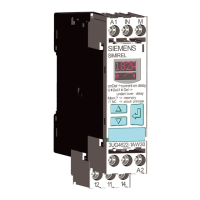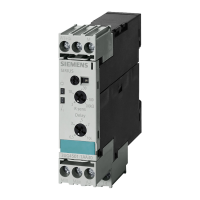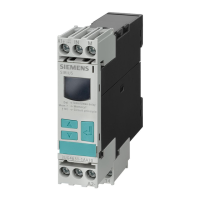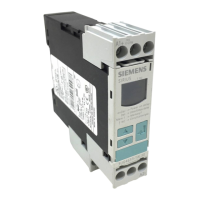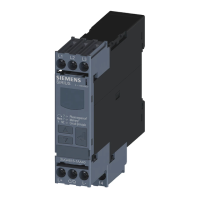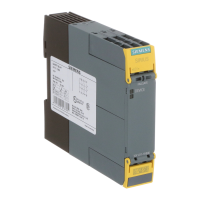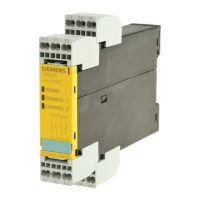corresponds to the insulation resistance calculated in the next measuring cycle and is lower than
the set threshold, output relay K1 responds depending on the device conguration.
This adaptive measuring principle is suitable for detecting symmetrical insulation faults.
Monitoring
The system to be monitored is connected to the measuring signal inputs L+, L-. The terminals can
be connected to any conductor (phase, +/- potential, or N conductor). The measuring signal
inputs must be connected to dierent conductors.
The ground potential is connected to the terminals and KE.
KE stands for control ground and is used for monitoring the fault-free ground connection of the
insulation monitoring relay.
The 3UG4582 insulation monitoring relays work according to the closed-circuit principle NC. The
3UG4583 insulation monitoring relays work in accordance with the set relay switching behavior
(closed-circuit principle NC or open-circuit principle NO).
After applying the rated control supply voltage, the insulation monitoring relay goes through an
internal test that checks the proper functioning of the operational device. The test encompasses
an internal test of the device at hardware and rmware level (on the 3UG4583, a settings check
is also carried out) , as well as system diagnostics with calculation of the system discharge
capacity of the rst measured value of the insulation resistance. If there are no internal device
faults or external faults on completion of this test, the output relays change their switching state
(if closed-circuit principle is set). The time for this test can be 10 s - 15 s with purely AC systems.
The circuit is opened instantaneously after detection of a fault. In AC systems with DC
components, as is the case when rectiers are used, up to 15 s can be needed.
Note
If the 3UG4583 insulation monitoring relay is used for monitoring the winding insulation of a
motor, the function test rst results in a fault message if the closed-circuit principle is selected,
since the device is not applied to the supply voltage until a measurement is possible on the
switched-o motor. Either this fault must be hidden by downstream logic, or the open-circuit
principle must be set. The output relays would only pick up if an insulation fault or internal device
faults are detected. However, the fault "Missing supply voltage" can then no longer be detected.
If the measured value undershoots the set threshold in the case of the 3UG4582 insulation
monitoring relays, output relay K1 drops out. If the measured value overshoots the threshold
including hysteresis, output relay K1 picks up.
The principle of operation of the 3UG4583 insulation monitoring relays can be congured via
DIP switch 4:
In the functional principle 1 x 2 changeover contacts, both output relays K1 and K2 respond to
threshold R1 (warning). The settings of threshold R2 have no inuence on the principle of
operation. If the measured value undershoots the set threshold, the output relays switch to the
fault status. If the measured value overshoots the set threshold including hysteresis, the output
relays revert to the original state.
In the functional principle 2 x 1 changeover contacts, output relay K1 responds to threshold R1
(shutdown) and output relay K2 responds to threshold R2 (warning). If the measured value
undershoots the set threshold R2 (warning), output relay K2 switches. If the measured value
3UG458. insulation monitoring relay.
9.4 3UG4582/3UG4583 insulation monitoring relays
SIRIUS 3UG4 / 3RR2 monitoring relay
Equipment Manual, 07/2021, NEB927043002000/RS-AD/005 179
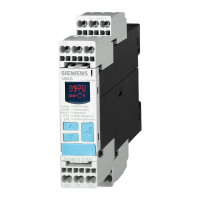
